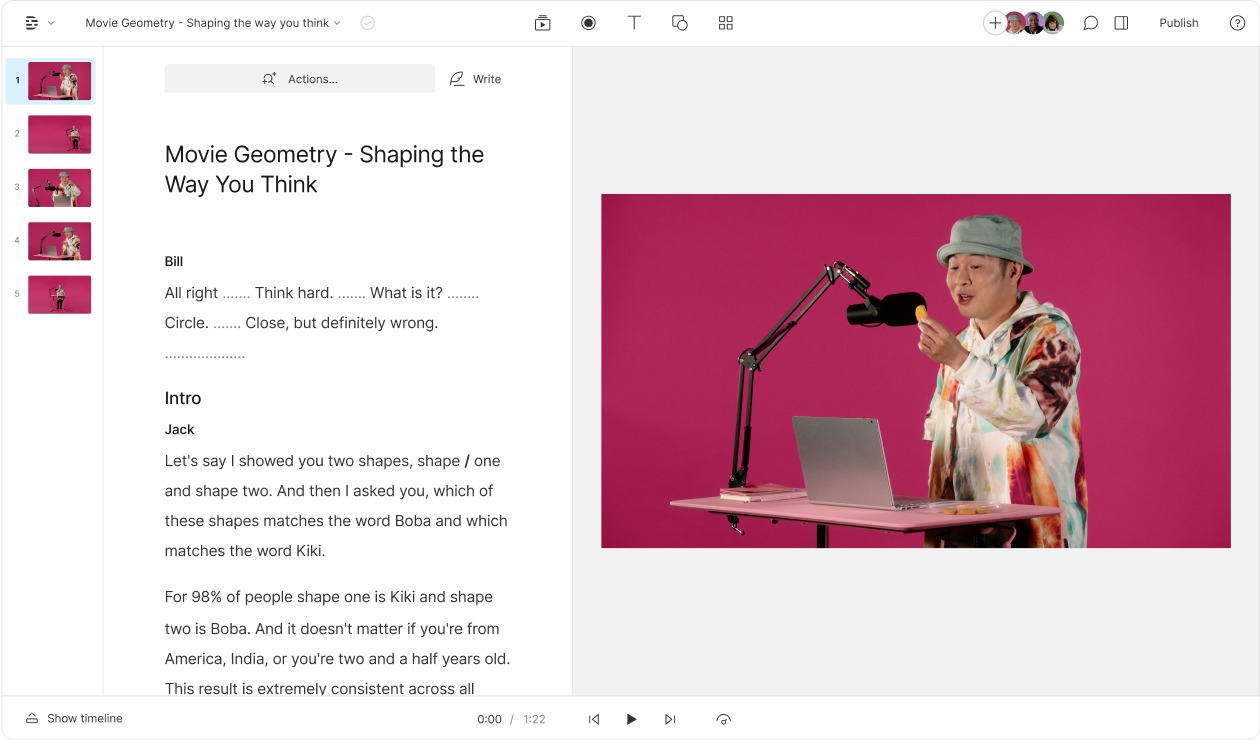What type of content do you primarily create?




Case studies should be your secret weapon—real stories that show potential buyers exactly what's possible when someone just like them uses your product. Instead, most are glorified testimonials that leave the best parts on the cutting room floor.
The problem? Most companies obsess over the what ("Client X implemented our solution") while completely skipping the how. That's exactly where the magic happens—in the messy, instructive details that actually teach, inspire, and yes, sell.
We've all seen those eye-popping metrics: "5x more sales generated" or "40% less time spent." They look impressive until you realize there's no story explaining how they got there. Numbers without narrative are just mathematical confetti—pretty but ultimately meaningless.
After years of producing case studies for companies across different industries, I've found that the difference between forgettable and fantastic isn't luck or budget—it's having a case study production process that captures the right details at the right time with the right tools.
Definition and core benefits of multimedia case studies
Multimedia case studies combine text, images, videos, and audio to present success stories in a more engaging way. They provide a comprehensive breakdown of the problem, the proposed solution, and the resulting wins, making the narrative easier to follow. Incorporating a variety of media formats appeals to both visual and auditory learners, boosting content consumption and retention. According to research from the Content Marketing Institute, showcasing multiple media elements can enhance credibility by offering real-life examples of a company's capabilities. This holistic approach also highlights details that might otherwise get overlooked in a purely text-based piece.
What makes a compelling multimedia case study?
A multimedia customer case study should feel like a win to everyone invested in their creation:
- Positive press for the customer you're featuring
- Demand generation content your marketing team can promote through ads, email, etc.
- Conversation starters your sales reps can use to warm up cold leads
- Inspiring stories your prospective customers can relate to
Multimedia case studies go a long way in B2B marketing, where trust is earned gradually over a longer buying process that involves multiple decision makers.
Superside, for example, uses multimedia customer case studies to showcase the value props of its unique creative subscription service and the different projects clients have produced through the platform.

Then there's Mutiny, which positions many of its multimedia case studies as "playbooks" that chronicle different marketing experiments that have been run using its conversion optimization platform.

Producing your own library of multimedia customer case studies like this comes with its inherent challenges:
- Finding the right customers to feature and stories to tell
- Incorporating video to make it more engaging
- Avoiding sensitive info or competitive intel without sacrificing value
- Navigating multiple levels of approval before publishing
- Distributing the case study once it's published
Luckily, these challenges can be overcome with the right process in place.
How to create multimedia customer case studies
1. Find ideal customers for your case studies
Naturally, the first thing you'll need to start producing multimedia customer stories is willing customers with stories worth sharing.
Some great sources for potential case-study candidates can include:
- Customer databases like Salesforce or HubSpot where all your customers are listed out with details like contact info, industry, company size, sign up date, and more
- Nominations from customer success reps, who likely have the most context on who your happiest customers are and potential angles you can explore
- Discounts and other incentives introduced by sales reps when a new customer signs on in exchange for participation in a case study
I recommend tracking your multimedia case study candidates in a spreadsheet that includes the following fields:
| Customer | Website | Contact | Industry | Use case | Results | Status | |
|---|---|---|---|---|---|---|---|
| Name of company | Link to website | Name and jobt titles of interviewees | Contact info to schedule interview | Education, Tech, Agency, etc. | Products, features, services used | Key outcomes worth sharing | Potential, contacted, scheduled, interviewed, etc. |
2. Schedule customer interviews
When you reach out to customers for a multimedia case study interview, remember that they're already paying to use your products or services on top of making time for you in their busy schedules.
While some customers might be excited about the chance to be featured, others might appreciate a tangible incentive that can range from:
- Exposure to your email list and social media followers if there's an overlap in target audiences between your brand and the customer's
- An Amazon gift card
- A donation to the charity of the customer's choice
- A discount or credit for your product or service
When you reach out, try to send the request from someone the customer already knows and trusts, like a coworker or the customer success manager assigned to their account.
I recommend using a scheduling tool like Calendly or Cal.com to avoid back-and-forth emails to find a time that works for both of you. For the meeting location, you can include a link to a Zoom call, Descript Rooms, or wherever you plan to host the multimedia interview.
You can adapt the following email template to reach out to customers for a multimedia case study interview:
Subject: [Your Company] would love to feature your success story!
Hi [Customer's Name],
I hope you're doing well. My name is [Your Name], and I'm [Your Position] at [Your Company]. I'm reaching out because we've been incredibly impressed with how you've been using our [product/service] to achieve [specific result or success].
We believe your story could inspire others and demonstrate the real-world benefits of our [product/service]. We would love to feature your experience in a case study on our website and marketing materials.
Would you be open to a 30-minute interview to discuss your journey and the impact [product/service] has had on your business?
As a token of our appreciation, we'd be happy to [incentive], and of course, we will share the final case study with you for approval before it goes live.
If you're interested, let me know your availability or you can pick a time that works for you here: [scheduling link].
Thanks for considering this, and we look forward to the possibility of showcasing your success!
[Your Full Name, Position at Company]
3. Prepare effective case study interview questions
Once you've scheduled your multimedia customer case study interview, it's often a good practice to send over an interview outline in advance so they can prepare answers if needed.
Multimedia case study interviews typically last 45 minutes, so you don't want them to waste time hunting for numbers or examples on the spot.
Here are some good questions to keep in mind:
- Briefly describe your company and your role within it.
- What was the biggest challenge you were facing as a [job title]? What was the impact of it on the business at large?
- What solutions did you try before discovering our product/service and why did you ultimately choose us?
- How has our product/service addressed these challenges, changed your day-to-day work, or affected the overall business?
- Can you share any measurable results or wins since implementing our product/service?
- What are your favorite features of our product/service?
- Have you received any feedback from your team or customers about our product/service?
“Who would you recommend our product/service to without any hesitation?” is a personal favorite of mine. It almost always gets an insightful and honest answer that doubles as a relatable testimonial.
During the actual interview, you don't need to stick to the script. Sometimes the conversation reveals a better story than the one you went in expecting to tell. Let your curiosity take the lead and ask those unscripted follow-up questions to see where they take you.
In his book Stop Asking Questions, Andrew Warner, host of the popular business podcast Mixergy, says, “The best interviews are conversations, not interrogations.”
Warner recommends getting aligned on the “Why” for both sides before you hit record—sharing what you hope to get out of the interview and also asking what your guest hopes to get out of it as well.
Sometimes your guests want to celebrate a recent win they're proud of, promote an upcoming launch, or tell a specific story about their brand. If you can accommodate them, they're more likely to get excited about the interview.
4. Record interviews using multitrack recording
While in-person customer interviews allow for higher quality video content, they can quickly introduce costs and complexity—especially when you can still create engaging multimedia case studies from remote recordings with a bit of planning.
But even with remote interviews, a lot can go wrong depending on how you record them.
In one of my first case study interviews, my recording software failed to capture my guest's side of the conversation. With no audio or transcript, I had to go off my memory and notes (and a bit of lip reading) to salvage it.
But choosing the right recording method isn't just about peace of mind—it's also about quality and flexibility.
I recommend using multitrack remote recording software like Descript that captures separate audio, video, and screen-sharing tracks locally for you and each of your guests—essential for creating professional multimedia customer case studies.

Using multitrack recording for your multimedia case studies, you can:
- Guarantee the highest quality audio and video capture
- Ensure local backup on the off-chance something goes wrong, like you lose your internet connection during the interview.
- Record multiple guests simultaneously while making it easier to manage cross-talk and interruptions during editing
- Generate transcripts and label speaker with greater accuracy
- Edit with more control, adjusting volume levels or removing background noise for individual speaker tracks
The biggest benefit: Repurposing the interview into other multimedia formats with more flexibility, speed, and polish (more on that later).
4. Generate and annotate interview transcripts
With your multimedia case study interview recorded, the next thing you'll want to do is transcribe it to make it easier to sift through the interview to find your story.
These days, you don't need to waste time or money on manual transcription services or suffer through DIY transcription. You can get an accurate transcript, including time codes and speaker labels, almost instantly using AI.
If you use Descript for transcription like I do, your transcript will be synced to your audio and video file during playback and editing.
There are several benefits to using AI transcription for multimedia customer case studies, like:
- Leaving highlights and comments on the transcript as you go over the interview recording to make notes
- Instantly removing filler words and repetition from the transcript and video at once
- Using AI to find the best moments in the interview, generate a summary, even brainstorm headlines all within the transcript
- Highlighting excerpts within the transcript to turn into clips

5. Draft your multimedia case study content
Now it's time to turn your 45-minute customer interview into a cohesive multimedia case study designed for both busy skimmers and curious readers.
Most multimedia case study articles follow a similar structure:
- TL;DR. Hook readers with a summary of success metrics and/or a compelling quote upfront.
- Background. Quickly introduce the main characters and any essential company context.
- Challenge. Frame the biggest problems facing the customer and identify their goals. Establish why the status quo wasn't working and how other solutions fell short.
- Solution. Walk through the process of solving the problem using your product/service. Include specific tips, features used, and examples.
- Results. Summarize the most significant outcomes from using your product. This can include both hard numbers as well as qualitative feedback.
It's worth creating a custom page template just for customer stories, like in this example from Superside, so you can surface the bottom line up-front for busy prospects.

With a transcript of your interview and a multitrack recording, writing your multimedia customer case study becomes a lot easier since you can now:
- Generate a rough draft or specific sections from the transcript with AI.
- Turn examples or visuals your customers screenshared during the interview into screenshots or GIFs you can embed into the article.
- Brainstorm supporting copy like headlines, meta descriptions, and more.

6. Add video and visual elements to case studies
If you captured your customer interview as a multitrack recording, you'll have an easier time editing it into polished multimedia content, such as:
- Long-form video of an edited version of the interview
- Screenshots and GIFs illustrating how the customer uses your product
- Short clips sharing your customer's expertise or endorsement, with landscape, square, or portrait variations for different channels and placements
- Video testimonials you can run as ads or embed on your website
- Highlight reels that showcase multiple customer testimonials
Voice-only audiogram video can be a great way to accommodate customers who may not be comfortable on camera while still creating effective multimedia case studies.
You can create these multimedia videos in Descript from start to finish or quickly produce a rough cut you can hand off to a professional video editor.
There are plenty of creative ways to use video to tell multimedia customer stories besides the standard talking head format, like combining animated text with screen sharing to showcase a specific feature.

6. Get feedback and approval before publishing
Unlike most articles on your blog, you'll need explicit permission from the customer before you can publish your multimedia case study.
Depending on the company's size and industry that might include approval from its legal team or senior leadership to make sure the brand is reflected well and no sensitive information is shared.
Generally, larger enterprises or public corporations will have more layers of approval to navigate than small businesses and private companies.
To be mindful of the customer's time and avoid unnecessary back and forth when approving multimedia case studies:
- Leave comments on specific sections in the draft where you'd like their input
- Be upfront about exactly how you plan to use the interview early on in the process—you don't want to waste time creating video ads if the customer isn't comfortable with it
- Avoid details that may damage the brand reputation or give away sensitive info
- Don't be afraid to lightly edit quotes to keep them coherent
- Invite the customer to suggest changes and make comments directly in the draft
7. Publish and promote your multimedia case studies
Once you've secured permission and finally published your multimedia customer case study, you might be inclined to move on to the next one in your pipeline. But you're not done with it yet.
What's the point of a shiny new multimedia case study if no one sees it?
Here's how you can help your new multimedia customer case study get in front of the right people:
- Send a link to the customer you interviewed in case they want to share it with their personal network
- Let your sales team know that a new case study is up, and add it to a sales enablement library to arm sales reps if you have one
- Share any video clips with your audience on Instagram, Facebook, LinkedIn, etc. Make sure to include a link to the full case study in the caption.
- Embed video clips with a link to the full case study on relevant pages on your website or blog.
- Design carousel posts that summarize the customer story, which can include a mix of images and videos depending on the platform.
Since multimedia case studies are often shared through direct messages and social media feeds, I recommend optimizing the Open Graph image and text (i.e. the preview that renders when a link is shared) to sell the story before the click.

Measuring ROI and selecting effective formats for multimedia case studies
One straightforward way to gauge the impact of multimedia case studies is to track any uptick in leads or sales generated, especially when contrasted with text-only examples. Engagement metrics like time on page and click-through rates also offer insight into how viewers interact with your content. Adding interactive elements, such as clickable charts or embedded quizzes, can amplify interest by holding audience attention. According to recent findings, balancing production costs with potential returns is critical for long-term success. This often involves matching more complex narratives—like data-heavy demos—to video or interactive formats, while using concise text summaries for simpler storylines.
Quality multimedia case studies require a solid process
Multimedia customer case studies can be one of the most powerful forms of social proof in your B2B marketing mix—but only when they prioritize telling a good story that teaches and inspires just as well as it sells.
It starts with an intentional process, from sourcing customers to recording interviews to creating multimedia content, that doesn't just make case studies easier to produce; it makes them more interesting to consume.
FAQs
Why are multimedia case studies more engaging than text-only examples?
They combine multiple media modes to appeal to different learning styles, including visual and auditory, making the content more immersive. According to the Content Marketing Institute, adding videos, images, or audio can significantly increase audience engagement. Seeing real-world examples and testimonials can reinforce credibility, helping potential buyers picture themselves achieving similar outcomes. When people see a product or service in action, they're more likely to remember and share these stories with others.
How can AI technology streamline multimedia case study production?
AI can handle tasks like transcription, data analysis, and drafting initial summaries, letting your team focus on higher-level decision-making. Tools driven by AI also automate routine editing jobs, such as removing filler words and adding accurate captions. This can save creators a ton of time and money, while supporting better accessibility features. AI also spots patterns in large data sets, making it easier to pinpoint the strongest stories to highlight in your case study.





























%201.svg)











